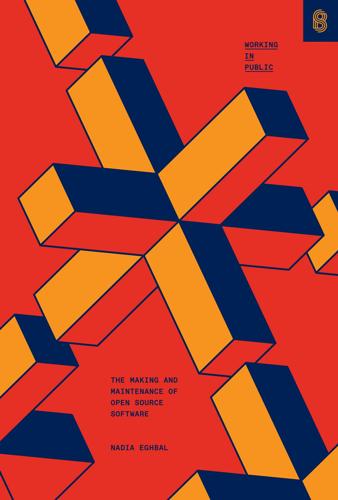
Working in Public: The Making and Maintenance of Open Source Software
by
Nadia Eghbal
Published 3 Aug 2020
,” The Vue Point, Medium, September 11, 2017, https://medium.com/the-vue-point/vue-is-now-on-opencollective-1ef89ca1334b. 258 Sophie Alpert (@sophiebits), “Is this what it feels like . . .,” Twitter, November 10, 2019, 7:27 p.m., https://twitter.com/sophiebits/status/1193686560413106177. 259 Owen Phillips, “The Anonymous MVP of the NBA Finals,” The Outline, June 12, 2017, https://theoutline.com/post/1706/the-anonymous-mvp-of-the-nba-finals-velocityraps-illegal-streaming. 260 Ryan Regier, “We Are in a Golden Age of Illegal Sports Streaming and It’s Showing Us How Copyright Infringement Can Result in Better Content,” Medium, January 20, 2019, https://medium.com/@ryregier/we-are-in-a-golden-age-of-illegal-sports-streaming-and-its-showing-us-how-copyright-infringement-d835ae291ed2. 05 261 Jane Jacobs, The Death and Life of Great American Cities (New York: Vintage Books, 1992), 55. 262 Office of the Under Secretary of Defense (Comptroller), “National Defense Budget Estimates for FY2020,” United States Department of Defense, May 2019, https://comptroller.defense.gov/Portals/45/Documents/defbudget/fy2020/FY20_Green_Book.pdf. 263 Guido van Rossum, “[Python-Committers] Transfer of Power,” The Python-Committers Archives, July 12, 2018, https://mail.python.org/pipermail/python-committers/2018-July/005664.html. 264 Jake Edge, “PEP 572 and Decision-Making in Python,” LWN.net, June 20, 2018, https://lwn.net/Articles/757713/. 265 Guido van Rossum, “A Different Way to Focus Discussions,” LWN.net, May 18, 2018, https://lwn.net/Articles/759557/. 266 Jonathan Zdziarski, “On the State of Open Source,” Zdziarski’s Blog of Things, October 3, 2016, https://www.zdziarski.com/blog/?
…
In response to a question about Nvidia’s lack of support for Linux (Nvidia is a manufacturer of graphics processing units, or GPUs), he turned to the camera, gave it the middle finger, and growled, “Nvidia, fuck you!”21 It’s not just Torvalds’s communication skills but also his governance style that helped him gain notoriety. In one of his essays, Raymond called this style “benevolent dictator,”23 which was later adapted by Guido van Rossum, author of the Python programming language, into the better-known phrase “Benevolent Dictator for Life” (BDFL), to describe authors of open source projects who retain control even as the project grows. Although the Linux Foundation reports more than 14,000 contributors to the Linux kernel since 2005,24 Torvalds is still the only person who’s allowed to merge those contributions into the main project.25 Although there is no shortage of memorable hacker personalities, the free and early open source ethos is also defined by a startling lack of interest in its people.
…
What I am saying is that this emerging third model is (a) distinct from [markets and firms], and (b) has certain systematic advantages over the other two in identifying and allocating human capital/creativity.112 A few of the conditions that Benkler identifies as necessary to pull off commons-based peer production are intrinsic motivation, modular and granular tasks, and low coordination costs. Intrinsic motivation is the currency of the commons: members do the work because they want to do it. In the case of open source, it’s assumed that developers participate because they enjoy writing code. Guido van Rossum, for example, wrote the programming language Python while looking for a “‘hobby’ programming project that would keep me occupied during the week around Christmas.”113 And Linus Torvalds released the Linux kernel and operating system as “just a hobby, won’t be big and professional,”114 then released the version control system Git as “some scripts to try to track things a whole lot faster.”115 Benkler proposes that, in order to keep people motivated, tasks must be modular and granular: When a project of any size is broken up into little pieces, each of which can be performed by an individual in a short amount of time, the motivation necessary to get any given individual to contribute need only be very small.116 Modularity refers to how the project is organized.
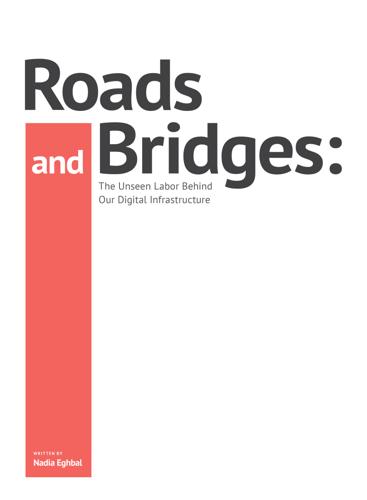
Roads and Bridges
by
Nadia Eghbal
By individuals or a group of individuals Finally, many digital infrastructure projects are developed and maintained entirely by independent developers, or a community of developers. A few examples are as follows: Python, a programming language, was developed and published by computer scientist Guido van Rossum in 1991. Van Rossum claimed he was looking for a ‘hobby’ programming project that would keep me occupied during the week around Christmas.[59] The project took off, and Python is now considered to be one of the most popular programming languages today.[60] Van Rossum remains the principal author of Python (also known as a benevolent dictator for life, or BDFL, among developers) and is currently employed by Dropbox, whose software relies heavily on Python.[61] Python is partially managed by the Python Software Foundation, created in 2001, which has a number of corporate sponsors, including Intel, HP, and Google.
…
Data accessed May 20, 2016. https://www.openhub.net/languages/compare [43] https://story.californiasunday.com/tim-hwang-infrastructure-tourist [44] http://blog.codinghorror.com/the-magpie-developer/ [45] https://en.wikipedia.org/wiki/Internet_Engineering_Task_Force [46] https://en.wikipedia.org/wiki/Go_(programming_language) [47] https://www.quora.com/How-was-the-idea-to-develop-React-conceived-and-how-many-people-worked-on-developing-it-and-implementing-it-at-Facebook/answer/Bill-Fisher-17 [48] https://en.wikipedia.org/wiki/React_(JavaScript_library) [49] https://en.wikipedia.org/wiki/Swift_(programming_language) [50] https://github.com/facebook/react/blob/master/PATENTS [51] http://venturebeat.com/2015/06/13/docker-now-valued-at-1b-paid-someone-799-for-its-logo-on-99designs/ [52] http://www.bloomberg.com/news/articles/2015-04-14/docker-said-to-join-1-billion-valuation-club-with-new-funding [53] https://www.crunchbase.com/organization/meteor [54] http://info.meteor.com/blog/announcing-meteor-galaxy [55] http://venturebeat.com/2015/12/06/its-actually-open-source-software-thats-eating-the-world/ [56] http://words.steveklabnik.com/is-npm-worth-26mm [57] https://www.crunchbase.com/organization/github [58] http://www.wsj.com/articles/SB10001424052702303292204577517111643094308 [59] https://www.python.org/doc/essays/foreword/ [60] http://blog.codeeval.com/codeevalblog/2015#.VjvKZhNViko= [61] https://en.wikipedia.org/wiki/Guido_van_Rossum [62] http://skillcrush.com/2015/02/02/37-rails-sites/ [63] https://twistedmatrix.com/trac/wiki/SuccessStories [64] https://twistedmatrix.com/glyph/ [65] https://peerj.com/preprints/1233.pdf [66] Email interview with Arash Payan [67] https://medium.com/@shazow/urllib3-stripe-and-open-source-grants-edb9c0e46e82 [68] https://readthedocs.org/sustainability/ [69] https://blog.mozilla.org/blog/2015/12/10/mozilla-open-source-support-first-awards-made/ [70] http://blog.readthedocs.com/ads-on-read-the-docs/ [71] Skype interview with Eric Holscher [72] http://david.heinemeierhansson.com/2013/the-perils-of-mixing-open-source-and-money.html [73] http://blog.codinghorror.com/is-money-useless-to-open-source-projects/ [74] http://www.datamation.com/open-source/linus-torvalds-and-others-on-community-burnout-1.html [75] http://www.apple.com/customer-letter/ [76] https://www.blackducksoftware.com/future-of-open-source [77] http://redmonk.com/sogrady/2013/12/19/dvcs-and-git-2013/#ixzz2qyfVpSR9 [78] As of January 6, 2016. https://www.openhub.net/repositories/compare [79] http://readwrite.com/2014/01/21/git-subversion-developers [80] https://github.com/blog/841-those-are-some-big-numbers [81] https://en.wikipedia.org/wiki/GitHub [82] https://github.com/blog/1724-10-million-repositories [83] http://dirkriehle.com/publications/2008-2/the-total-growth-of-open-source/ [84] https://en.wikipedia.org/wiki/Stack_Overflow [85] https://creativecommons.org/licenses/by-sa/2.0/ [86] http://meta.stackexchange.com/questions/271080/the-mit-license-clarity-on-using-code-on-stack-overflow-and-stack-exchange [87] http://meta.stackexchange.com/questions/272956/a-new-code-license-the-mit-this-time-with-attribution-required [88] http://www.infoworld.com/article/2615869/open-source-software/github-needs-to-take-open-source-seriously.html [89] http://www.infoworld.com/article/2611422/open-source-software/github-finally-takes-open-source-licenses-seriously.html [90] http://www.theregister.co.uk/2013/04/18/github_licensing_study/ [91] https://twitter.com/monkchips/status/247584170967175169 [92] http://blog.codinghorror.com/please-dont-learn-to-code/ [93] https://medium.com/@wob/the-sad-state-of-web-development-1603a861d29f#.443lcznv1 [94] https://coderanger.net/funding-foss/ [95] Email interview with Hynek Schlawack [96] http://timesofindia.indiatimes.com/tech/tech-news/Security-experts-expect-Shellshock-software-bug-to-be-significant/articleshow/43657819.cms [97] http://www.scmagazineuk.com/openssh-flaw-opens-the-door-to-brute-force-attackers/article/428304/ [98] http://arstechnica.com/security/2016/01/bug-that-can-leak-crypto-keys-just-fixed-in-widely-used-openssh/ [99] https://medium.com/@christophera/i-ve-been-working-to-address-this-gap-for-a-while-thus-my-recent-exploration-of-the-commons-in-my-8094d41a874a#.qyh31ida4 Quote edited for clarity by source

Python Web Development With Django
by
Jeff Forcier
Note At the time of this writing, the Django components that App Engine ships with are part of an outdated yet stable release of Django (0.96.1). Google App Engine Helper for Django The key to making your experience with App Engine a bit more like “real” Django development is the Google App Engine Helper for Django.This is an open-source Googlesponsored project (with Python creator Guido van Rossum being listed as one of its contributors) that aims to make App Engine a more comfortable environment for those with Django experience. It even enables you to swap in a more current version of Django instead of the one that App Engine ships with. Getting the SDK and the Helper Before we go any further, we need to get the necessary software.You can download the Google App Engine SDK for your platform at http://code.google.com/p/ googleappengine/, the SDK Project home page.
…
For a more comprehensive list, please visit the book’s Web site, withdjango.com. n Google App Engine http://code.google.com/appengine/ n App Engine SDK Project http://code.google.com/p/googleappengine/ n App Engine Tutorial http://code.google.com/appengine/docs/gettingstarted/ Online Resources n Google App Engine Helper for Django http://code.google.com/p/google-app-engine-django/ n Using the Google App Engine Helper for Django (Matt Brown, May 2008) http://code.google.com/appengine/articles/appengine_helper_for_django.html n VIDEOS Rapid Development with Python, Django, and Google App Engine (Guido van Rossum, May 2008) http://sites.google.com/site/io/rapid-development-with-python-django-and-googleapp-engine n Introducing GAE at Google Campfire (various,Apr 2008, 7 videos) http:// innovationstartups.wordpress.com/2008/04/10/google-app-engine-youtubes/ 335 This page intentionally left blank Appendix F Getting Involved in the Django Project D jango is not just a Web framework.
…
It’s also a community of coders, testers, translators, question-answerers, and a global collective of volunteers.The Django AUTHORS file lists more than 200 contributors, and there are many, many others who contribute in large and small ways to keep the project going. Django is an exemplary open source project—Python creator Guido van Rossum has said as much—and among other things that means it offers many ways for interested people to get involved. It’s likely that, like many others, you find Django makes your life as a Web developer easier and more fun, and you may find your incredible surplus of leisure and happiness inspires you to give something back.

Dreaming in Code: Two Dozen Programmers, Three Years, 4,732 Bugs, and One Quest for Transcendent Software
by
Scott Rosenberg
Published 2 Jan 2006
For instance: Should the language give programmers the power to poke directly into the computer’s memory—along with the freedom to make machine-crashing mistakes? Or should the language create zones of safety that limit the possibility of error—at the cost of tying the programmer’s hands? For the Vista prototype, Hertzfeld had used a language called Python, invented in the late 1980s by a Dutch programmer named Guido van Rossum who named it in honor of Monty Python’s Flying Circus, the British comedy troupe. (Monty Python’s form-smashing absurdism has always found some of its truest fans in computer labs; we call the flood of unsolicited and unwanted email “spam” thanks to the Internet pioneers who, looking to name the phenomenon, recalled a Python routine featuring a luncheonette menu offering nothing but variations on “eggs, sausage, spam, spam, spam, and spam.”)
…
This approach could make life easier for programmers; it also tended to make for slower and sometimes less reliable databases. As it happened, the community of Python programmers had already created an ambitious and well-known example of an object database. It was called ZODB, for Zope Object Database. McCusker’s anonymous email correspondent had referred to it. At that time Python creator Guido van Rossum worked for the company that produced it. ZODB was the answer to Chandler’s problems, Anderson concluded. At first Sagen, who had written Shimmer and had been in charge of Chandler’s back end, didn’t agree, but he admitted that his experience was more in programming for servers than for clients—the programs that actual users employ—and eventually bowed to Anderson’s choice.
…
Don’t worry, the company reassured its people. Go forth and scratch your itches! Google was gaining a reputation for having built a sort of engineers’ paradise where algorithms ruled the roost and coders called the shots. Those lucky enough to be employed at the Googleplex—including Andy Hertzfeld and Python’s Guido van Rossum, both of whom joined Google in 2005—found a working environment that, for a spell, had escaped the stasis of software time. Google had its share of half-baked products, but no one would dispute the value of its successes—from its original search engine to its keyword-based advertising business and its popular free email service.

SciPy and NumPy
by
Eli Bressert
Published 14 Oct 2012
A big thanks goes to my wife and son, Judith van Raalten and Taj Bressert, for their help and inspiration, and willingness to deal with me being huddled away behind the computer for endless hours. Chapter 1. Introduction Python is a powerful programming language when considering portability, flexibility, syntax, style, and extendability. The language was written by Guido van Rossum with clean syntax built in. To define a function or initiate a loop, indentation is used instead of brackets. The result is profound: a Python programmer can look at any given uncommented Python code and quickly understand its inner workings and purpose. Compiled languages like Fortran and C are natively much faster than Python, but not necessarily so when Python is bound to them.

Rebel Code: Linux and the Open Source Revolution
by
Glyn Moody
Published 14 Jul 2002
Alongside such worthy undertakings, a more formal approach to teaching programming that would naturally lead people to contribute to open source projects is needed. This is one of the aims of a project called Computer Programming For Everybody (CP4E), the brainchild of another key figure in the world of open source. Guido van Rossum was born in 1956, in the Netherlands. In the late 1980s, while living in Amsterdam, he worked on a branch of the Amoeba project, the main research interest of Andrew Tanenbaum, the creator of Minix, who is a professor at the Free University in the city. “I remember Tanenbaum asking me once, ‘Are you a researcher or a developer?’”
…
Initially, it had sold a proprietary solution, but in November 1998 Zope’s venture capitalist convinced its founders that they should release the software as open source to drive a wider uptake and to enjoy all the other benefits of making code freely available. Zope generates revenues through providing support, consultancy, and training in the usual free software fashion. Zope draws deeply on Python for its power, so it was appropriate that Python’s creator, Guido van Rossum, should join the company as director of its PythonLabs in October 2000, along with the other main Python developers. Zope also became cosponsor of the Python Software Foundation, which was launched in March 2001 as the guardian of Python’s intellectual property. The second founding sponsor was ActiveState, another company that has successfully built a business around open source software.
…
Since then, the company has come out with programs based on open source software such as Perl, Python, Tcl, and Mozilla as well as support for Microsoft’s developer tools. ActiveState’s growing stature in the open source world can be gauged from the roster of top hackers who joined its technical advisory board in March 2001: Larry Wall, Brendan Eich (the main architect for Mozilla), Guido van Rossum, and Rasmus Lerdorf. The swelling ranks of what might be termed second-generation open source companies such as MySQL, Zend, Zope, and ActiveState are a clear indication that whatever the setbacks the early players have suffered, a business built around free software can still thrive. Yet, for all their success, such companies are no longer the main engines driving the uptake of open source in corporates.

Exploring Python
by
Timothy Budd
Published 17 Feb 2009
A solid foundation in one language (such as Python) makes it much easier to learn a second Exploring Python – Preface 4 (or third, or forth). An appendix at the back of this book provides hints as to how one should approach the task of learning a new language. History of Python Python was designed by Guido van Rossum while he was working at the CWI (the Centrum voor Wiskunke and Informatica; literally “center for wisdom and informatics”) a world-class research lab in the Netherlands. The CWI group he was associated with designed a programming language called ABC. I was fortunate to spend a year with this group in 1985.
…
This empowers the student to take control of his or her own voyage of discovery, instead of simply playing the role of a passive container into which the instructor (or the book) pours information. I have discussed this active learning approach in my earlier remarks for the student. But the fact that simple things are easy to write in Python should not be an excuse to imagine that the language is just a toy. It is a credit to the good design skills of Guido van Rossum (the language designer) and countless others that simple ideas are simple to express, and complex ideas can also be illustrated with simple examples. In what other language might an introductory textbook include examples of a blog, a wiki, or an XML parser? Python is also an excellent vehicle for teaching computer science.
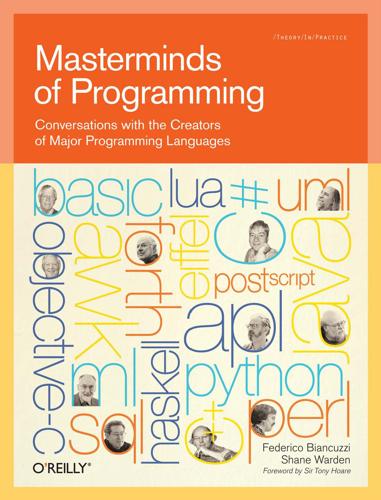
Masterminds of Programming: Conversations With the Creators of Major Programming Languages
by
Federico Biancuzzi
and
Shane Warden
Published 21 Mar 2009
If you are looking for inspiring thoughts regarding software and programming languages, you will need a highlighter, or maybe two, because I promise that you will find plenty of them throughout these pages. —Federico Biancuzzi Organization of the Material The chapters in this book are ordered to provide a varied and provocative perspective as you travel through it. Savor the interviews and return often. Chapter 1, C++, interviews Bjarne Stroustrup. Chapter 2, Python, interviews Guido van Rossum. Chapter 3, APL, interviews Adin D. Falkoff. Chapter 4, Forth, interviews Charles H. Moore. Chapter 5, BASIC, interviews Thomas E. Kurtz. Chapter 6, AWK, interviews Alfred Aho, Peter Weinberger, and Brian Kernighan. Chapter 7, Lua, interviews Luiz Henrique de Figueiredo and Roberto Ierusalimschy.
…
” * * * [1] http://www.open-std.org/JTC1/sc22/wg21/docs/TR18015.pdf/ [2] http://www.research.att.com/~bs/oopsla.pdf/ [3] http://www.open-std.org/jtc1/sc22/wg21// [4] http://www.research.att.com/~bs/C++0xFAQ.html/ Chapter 2. Python Python is a modern, general-purpose, high-level language developed by Guido van Rossum as a result of his work with the ABC programming language. Python’s philosophy is pragmatic; its users often speak of the Zen of Python, strongly preferring a single obvious way to accomplish any task. Ports exist for VMs such as Microsoft’s CLR and the JVM, but the primary implementation is CPython, still developed by van Rossum and other volunteers, who just released Python 3.0, a backward-incompatible rethinking of parts of the language and its core libraries.
…
Ports exist for VMs such as Microsoft’s CLR and the JVM, but the primary implementation is CPython, still developed by van Rossum and other volunteers, who just released Python 3.0, a backward-incompatible rethinking of parts of the language and its core libraries. The Pythonic Way What differences are there between developing a programming language and developing a “common” software project? Guido van Rossum: More than with most software projects, your most important users are programmers themselves. This gives a language project a high level of “meta” content. In the dependency tree of software projects, programming languages are pretty much at the bottom—everything else depends on one or more languages.

This Is for Everyone: The Captivating Memoir From the Inventor of the World Wide Web
by
Tim Berners-Lee
Published 8 Sep 2025
I liked this idea, but wanted to do it in a more general way (reusing the link for any media item). My objection to the IMG tag was based on my preference for clean powerful design, rather than an objection to images per se. A spirited discussion of the merits of our proposals followed – at one point a Dutch developer named Guido van Rossum chimed in. Marc later became one of Silicon Valley’s leading venture capitalists, and van Rossum invented Python, today the leading general-purpose programming language for artificial intelligence. Marc eventually just unilaterally added the IMG specification to Mosaic. As was his right, I suppose – the whole purpose of placing the web standards in the public domain was to allow for this sort of modification, without my explicit permission.
…
W3C has rapidly rolled out new features so that the web platform can compete with native apps on the phones. My preferred solution, of course, was that neither of these sides would win. I began pressing developers to come up with competing browsers, ones less in thrall to shareholders. In 1995, Guido van Rossum introduced Grail, a browser that would let you run applications within itself using his Python language. I met with Guido and encouraged him to develop Grail into a real contender – but, in exchange, he wanted me to start pushing Python inside W3C. I didn’t feel I could justify endorsing a programming language which, at that time, fewer than 1 per cent of software developers had ever used.

Programming in Scala
by
Martin Odersky
,
Lex Spoon
and
Bill Venners
Published 15 Jan 2008
For example, consider this list: scala> val people = List( new Person("Larry", "Wall"), new Person("Anders", "Hejlsberg"), new Person("Guido", "van Rossum"), new Person("Alan", "Kay"), new Person("Yukihiro", "Matsumoto") ) people: List[Person] = List(Larry Wall, Anders Hejlsberg, Guido van Rossum, Alan Kay, Yukihiro Matsumoto) Because the element type of this list, Person, mixes in (and is therefore a subtype of) Ordered[People], you can pass the list to orderedMergeSort: scala> val sortedPeople = orderedMergeSort(people) sortedPeople: List[Person] = List(Anders Hejlsberg, Alan Kay, Yukihiro Matsumoto, Guido van Rossum, Larry Wall) Now, although the sort function shown in Listing 19.12 serves as a useful illustration of upper bounds, it isn’t actually the most general way in Scala to design a sort function that takes advantage the Ordered trait.

Python for Unix and Linux System Administration
by
Noah Gift
and
Jeremy M. Jones
Published 29 Jun 2009
Also thanks to Alberto Valez, my boss at Sony Imageworks, for being possibly the best boss I ever had and giving me the chance to completely automate my job. Thanks to film editor Ed Fuller, who helped with advice on the book, and was a good friend during this process. Thanks to many people in the Python community. First, thanks to Guido van Rossum for writing a great language, for being a great leader, and for being patient with me when I asked for advice on the book. There are so many rock stars in the Python community who crank out useful tools that I use everyday. They include Ian Bicking, Fernando Perez and Villi Vainio, Mike Bayer, Gustavo Niemeyer, etc.
…
I also want to thank Linus Torvalds, the Debian folks, the Ubuntu folks, and anyone else who has ever worked on Linux. Almost every word that I typed was done on Linux. You made it incredibly simple to set up new environments and test different things. Thank you. Finally, but by no means least, I want to thank Guido van Rossum and everyone who has ever done any work on Python. I have been benefitting from your work for a number of years now. I was hired for my last two jobs because of Python. Python, the language, and Python, the community, have been both a great joy for me since I started working with it sometime around 2001–2002.
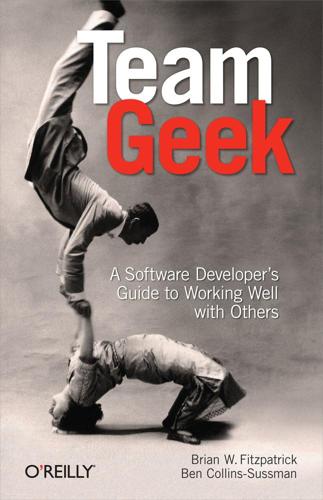
Team Geek
by
Brian W. Fitzpatrick
and
Ben Collins-Sussman
Published 6 Jul 2012
— Johnathan Nightingale “Team Geek is How to Win Friends and Influence People for programmers. It’s full of clear and actionable advice on how to be more happy, productive and effective on your technical team. Excellent and needed.” — Adrian Holovaty “Ben and Fitz say what I’ve been practicing but could never quite put in words.” — Guido van Rossum “Please send one copy to: Poul-Henning Kamp c/o FreeBSD core team Delivery no later than March 1994.” — Poul-Henning Kamp “Ben and Fitz come not to praise the myth of the lone programmer, but to bury it. They preside over its wake in a series of essays designed to teach right-brained engineers how to hack the most complex system they’ll ever encounter: people in a group.

Natural language processing with Python
by
Steven Bird
,
Ewan Klein
and
Edward Loper
Published 15 Dec 2009
Computing machinery and intelligence. Mind, 59(236): 433–460, 1950. [van Benthem and ter Meulen, 1997] Johan van Benthem and Alice ter Meulen, editors. Handbook of Logic and Language. MIT Press, Cambridge, MA, 1997. [van Rossum and Drake, 2006a] Guido van Rossum and Fred L. Drake. An Introduction to Python—The Python Tutorial. Network Theory Ltd, Bristol, 2006. [van Rossum and Drake, 2006b] Guido van Rossum and Fred L. Drake. The Python Language Reference Manual. Network Theory Ltd, Bristol, 2006. [Warren and Pereira, 1982] David H. D. Warren and Fernando C. N. Pereira. An efficient easily adaptable system for interpreting natural language queries.

WTF?: What's the Future and Why It's Up to Us
by
Tim O'Reilly
Published 9 Oct 2017
Under competitive pressure from Microsoft, which had built a browser of its own and had given it away for free (but without source code) in order to “cut off Netscape’s air supply,” Netscape had no choice but to go back to the web’s free software roots. At the meeting, which was held at the Stanford Court Hotel (now the Garden Court) in Palo Alto, I brought together Linus Torvalds, Brian Behlendorf (one of the founders of the Apache web server project), Larry Wall, Guido van Rossum (the creator of the Python programming language), Jamie Zawinski (the chief developer of the Mozilla project), Eric Raymond, Michael Tiemann (the founder and CEO of Cygnus Solutions, a company that was commercializing free software programming tools), Paul Vixie (the author and maintainer of BIND [Berkeley Internet Name Daemon], the software behind the Internet Domain Name System), and Eric Allman (the author of Sendmail, the software that routed a majority of the Internet’s email).
…
If your company has an Internet domain name—say nytimes.com or wsj.com or fortune.com—that name only works because of BIND, the software written by this man—Paul Vixie. The web server you use is probably Apache, created by a team co-founded by Brian Behlendorf, sitting here. That website also makes heavy use of programming languages like Perl and Python, written by Larry Wall, here, and Guido van Rossum, here. If you send email, it was routed to its destination by Sendmail, written by Eric Allman. And that’s before we even get to Linux, which you’ve all heard about, which was written by Linus Torvalds here. And here’s the amazing thing: All of these guys have dominant market share in important categories of Internet software without any venture capitalist giving them money, without any company behind them, just on the strength of building great software and giving it away to anyone who wants to use it or to help them build it.
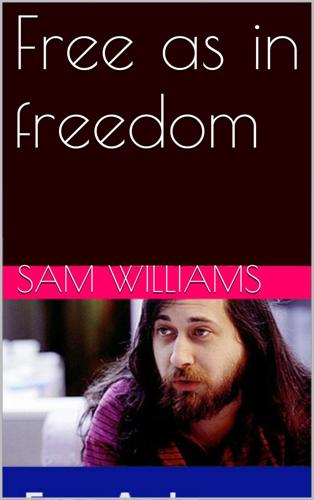
Free as in Freedom
by
Sam Williams
Published 16 Nov 2015
He decided to limit the list to west-coast developers such as Wall, Eric Allman, creator of sendmail, and Paul Vixie, creator of BIND. There were exceptions, of course: Pennsylvania-resident Raymond, who was already in town thanks to the Mozilla launch, earned a quick invite. So did Virginia-resident Guido van Rossum, creator of Python. "Frank Willison, my editor in chief and champion of Python within the company, invited him without first checking in with me," O'Reilly recalls. "I was happy to have him there, but when I started, it really was just a local gathering." For some observers, the unwillingness to include Stallman's name on the list qualified as a snub.
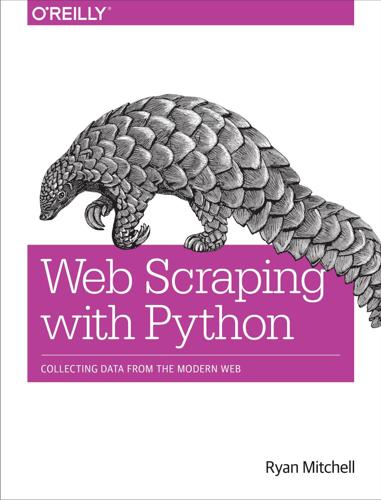
Web Scraping With Python: Collecting Data From the Modern Web
by
Ryan Mitchell
Published 14 Jun 2015
1 This line might be a reference to the Dutch computer scientist Edsger Dijkstra, who said in a 1978 talk: “I thought that it was a firm principle of language design...that in all respects equivalent programs should have few possibilities for different representations... Otherwise completely different styles of programming arise unnecessarily, thereby hampering maintainability, readability and what have you” (http://www.cs.utexas.edu/ ~EWD/transcriptions/EWD06xx/EWD660.html). Or it may simply be due to the fact that the original creator of Python, Guido van Rossum, is Dutch. No one seems to be entirely sure on this subject, however. Python at a Glance | 211 APPENDIX B The Internet at a Glance As the types of transactions the Internet is required to handle become increasingly complex, the terms and technologies used to describe these transactions also increa‐ ses in complexity.

Forge Your Future with Open Source
by
VM (Vicky) Brasseur
The relatively small size and scope allow an atomic commit to be reviewed more easily and thoroughly and is easier to roll back should something go wrong. Both the review and the easy rollback mitigate the risk of fatal bugs slipping into the project. BDFL Short for Benevolent Dictator For Life. BDFLs are rare in FOSS but they do exist. For example, Guido van Rossum was the BDFL of Python and Dries Buytaert is the BDFL of Drupal. A BDFL is typically the founder of the project. They have final say in and can veto all decisions related to the project, but it’s very rare that they use this power. Typically a BDFL will lean on the Benevolent part of the title by seeking consensus and always working toward what’s best for both the project and its community.
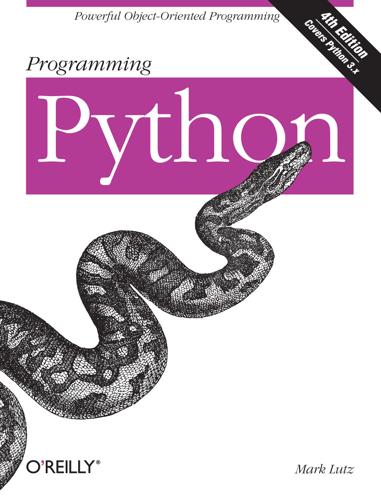
Programming Python
by
Mark Lutz
Published 5 Jan 2011
I opted to keep the conclusion itself, though, because it’s still relevant to many readers and bears some historic value. Well, that, plus the jokes… The forewords are gone For reasons similar to those of the prior two points, the accumulated forewords from the prior three editions were also dropped this time around. You can read all about Python creator Guido van Rossum’s historical rationale for Python’s evolution in numerous places on the Web, if you are so inclined. If you are interested in how Python has changed technically over the years, see also the “What’s New” documents that are part of the Python standard manuals set (available at http://www.python.org/doc, and installed alongside Python on Windows and other platforms).
…
(In fact, this is a particularly good script for Sue—something she might consider scheduling to run often, using a cron job on Unix, or a Startup folder or msconfig entry on Windows…) What’s in a Name? Though it’s a surprisingly well-kept secret, Python gets its name from the 1970s British TV comedy series Monty Python’s Flying Circus. According to Python folklore, Guido van Rossum, Python’s creator, was watching reruns of the show at about the same time he needed a name for a new language he was developing. And as they say in show business, “the rest is history.” Because of this heritage, references to the comedy group’s work often show up in examples and discussion.
…
Today, the nonprofit Python Software Foundation (PSF) oversees Python conferences and other noncommercial activities. The PSF was preceded by the PSA, a group that was originally formed in response to an early thread on the Python newsgroup that posed the semiserious question: “What would happen if Guido was hit by a bus?” These days, Python creator Guido van Rossum is still the ultimate arbiter of proposed Python changes. He was officially anointed the BDFL—Benevolent Dictator for Life—of Python at the first Python conference and still makes final yes and no decisions on language changes (and apart from 3.0’s deliberate incompatibilities, has usually said no: a good thing in the programming languages domain, because Python tends to change slowly and in backward-compatible ways).
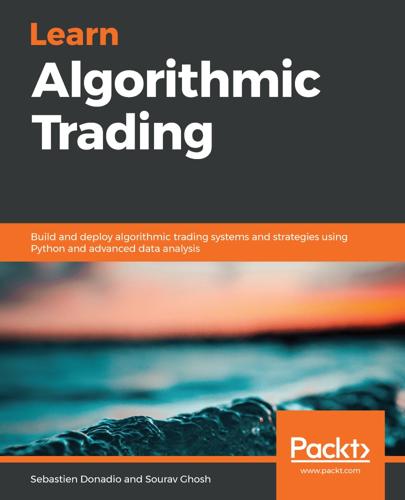
Learn Algorithmic Trading
by
Sebastien Donadio
Published 7 Nov 2019
We always associate Python with a general-purpose language with an understandable syntax and simplicity, while R was developed with statisticians as an end user by giving emphasis to data visualization. Even if Python can also give you the same visualization experience, R was designed for this purpose. R is not significantly more recent than Python. It was released in 1995 by the two founders, Ross Ihaka and Robert Gentleman, while Python was released in 1991 by Guido Van Rossum. Today, R is mainly used by the academic and research world. Unlike many other languages, Python and R allows us to write a statistical model with a few lines of code. Because it is impossible to choose one over the other, since they both have their own advantages, they can easily be used in a complementary manner.
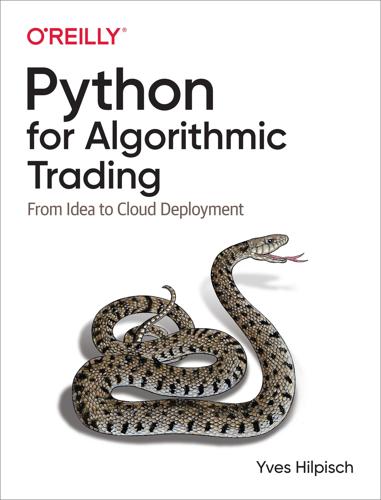
Python for Algorithmic Trading: From Idea to Cloud Deployment
by
Yves Hilpisch
Published 8 Dec 2020
Although Python for algorithmic trading is a niche at the intersection of Python programming and finance, it is a fast-growing one that touches on such diverse topics as Python deployment, interactive financial analytics, machine and deep learning, object-oriented programming, socket communication, visualization of streaming data, and trading platforms. For a quick refresher on important Python topics, read the Appendix A first. Python for Finance The Python programming language originated in 1991 with the first release by Guido van Rossum of a version labeled 0.9.0. In 1994, version 1.0 followed. However, it took almost two decades for Python to establish itself as a major programming language and technology platform in the financial industry. Of course, there were early adopters, mainly hedge funds, but widespread adoption probably started only around 2011.
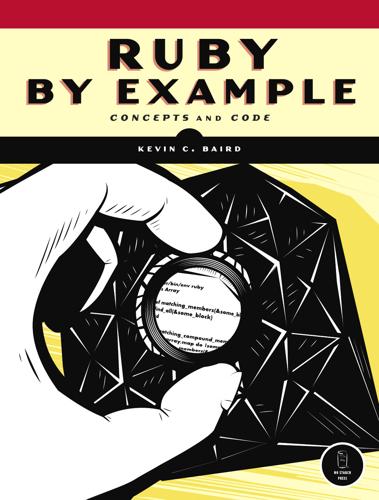
Ruby by example: concepts and code
by
Kevin C. Baird
Published 1 Jun 2007
PHP’s web integration is such an important part of its most frequent use (if not its design) that it is often best compared to other programming languages when combined with their own web integration systems, such Perl and Mason, or Ruby and eRuby or Rails. PHP’s creator Rasmus Lerdorf began work on the project that would eventually become PHP in 1995. You can find out more about it at http://php.net. Python Python is a language very similar to Ruby. Its creator, the “Benevolent Dictator For Life” Guido van Rossum, named it after the British comedy troupe Monty Python when he invented it in the early 1990s. It has strong, dynamic typing very similar to Ruby’s and a similarly clean syntax, which is aided by its use of semantically significant whitespace. In Python, neither functions, blocks of code, nor statements need to have an explicit end-of-line mark (often a semicolon).
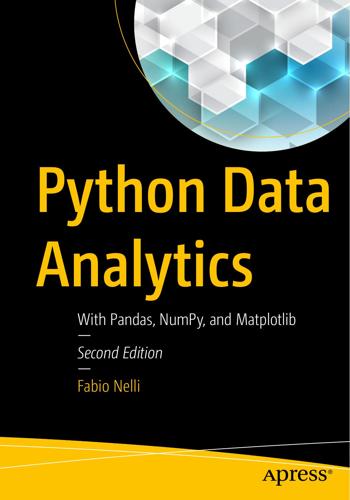
Python Data Analytics: With Pandas, NumPy, and Matplotlib
by
Fabio Nelli
Published 27 Sep 2018
This kind of ambiguity can create confusion, especially in terms of choosing which version to use and the differences between these two versions. One question that you surely must be asking is why version 2.x is still being released if it is distributed around a much more enhanced version such as 3.x. When Guido Van Rossum (the creator of Python) decided to bring significant changes to the Python language, he soon found that these changes would make the new version incompatible with a lot of existing code. Thus he decided to start with a new version of Python called Python 3.0. To overcome the problem of incompatibility and avoid creating huge amounts of unusable code, it was decided to maintain a compatible version, 2.7 to be precise.
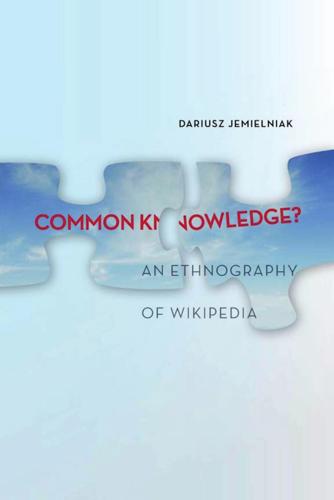
Common Knowledge?: An Ethnography of Wikipedia
by
Dariusz Jemielniak
Published 13 May 2014
Another is rotating dictatorship, in which control is occasionally passed from one member to another within a circle of senior co-developers; the Perl developers organize themselves this way. (1999/2004, pp. 101–102) Raymond possibly took the term from the “Benevolent Dictator for Life” nickname arguably given to Guido van Rossum, the creator of the Python programming language (Van Rossum, 2008). In Raymond’s concept, benevolent dictatorship is quite close to what Wales would refer to as a constitutional 1 6 2 L e a d e r s h i p T r a n s f o r m e d monarchy. Yet Wales was probably right to say that the term “benevolent dictatorship” may be obscure outside the hacker and open-source community and even evoke association with the likes of Ho Chi Minh, Josif Broz Tito, or Fidel Castro (interestingly, the Wikipedia entry on “benevolent dictatorship” has been a field of an ongoing edit war on who should be given as an example of a benevolent dictator, and so far no clear consensus has been established).

Text Analytics With Python: A Practical Real-World Approach to Gaining Actionable Insights From Your Data
by
Dipanjan Sarkar
Published 1 Dec 2016
Getting to Know Python Before we can dive into the Python ecosystem and look at the various components associated with it, we must look back at the origins and philosophy behind Python and see how it has evolved over time to be the choice of language powering many applications, servers, and systems today. Python is a high-level open source general-purpose programming language widely used as a scripting and across different domains. The brainchild of Guido Van Rossum, Python was conceived in the late 1980s as a successor to the ABC language , and both were developed at the Centrum Wiskunde and Informatica (CWI) , Netherlands. Python was originally designed to be a scripting and interpreted language, and to this day it is still one of the most popular scripting languages out there.
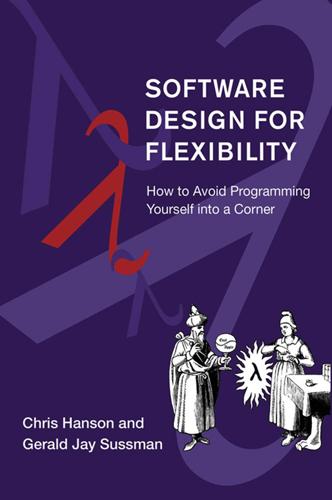
Software Design for Flexibility
by
Chris Hanson
and
Gerald Sussman
Published 17 Feb 2021
Adams IV; “T: A dialect of Lisp or, lambda: The ultimate software tool,” in Conference Record of the 1982 ACM Symposium on Lisp and Functional Programming, 114–122 (1982). [103]John C. Reynolds; “The discoveries of continuations,” in Proc. Lisp and Symbolic Computation, 233–248 (1993). [104]J.A. Robinson; “A Machine-Oriented Logic Based on the Resolution Principle,” in Journal of the ACM, 12(1) (January 1965): 23–41. [105]Guido van Rossum; The Python Language Reference Manual, ed. Fred L. Drake Jr., Network Theory Ltd, 2003. [106]Jane L. Russell, George D. Gatewood, and Thaddeus F. Worek; “Parallax Studies of Four Selected Fields,” in The Astronomical Journal, 87(2) (February 1982): 428–432. [107]Erik Sandewall; “From systems to logic in the early development of nonmonotonic reasoning,” in Artificial Intelligence, 175 (2011): 416–427
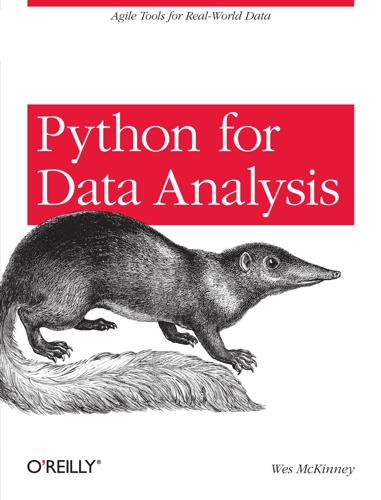
Python for Data Analysis
by
Wes McKinney
Published 30 Dec 2011
Suppose we had a large list of strings and we wanted to compare different methods of selecting all strings starting with a particular prefix. Here is a simple list of 700,000 strings and two identical methods of selecting only the ones that start with 'foo': # a very large list of strings strings = ['foo', 'foobar', 'baz', 'qux', 'python', 'Guido Van Rossum'] * 100000 method1 = [x for x in strings if x.startswith('foo')] method2 = [x for x in strings if x[:3] == 'foo'] It looks like they should be about the same performance-wise, right? We can check for sure using %time: In [561]: %time method1 = [x for x in strings if x.startswith('foo')] CPU times: user 0.19 s, sys: 0.00 s, total: 0.19 s Wall time: 0.19 s In [562]: %time method2 = [x for x in strings if x[:3] == 'foo'] CPU times: user 0.09 s, sys: 0.00 s, total: 0.09 s Wall time: 0.09 s The Wall time is the main number of interest.
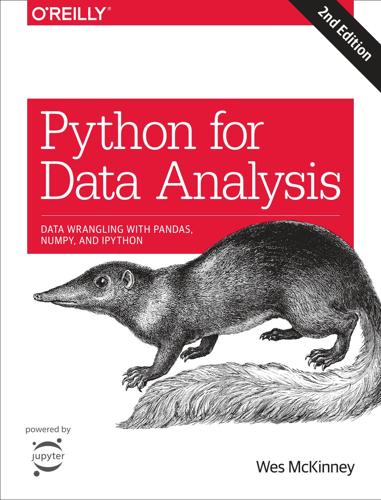
Python for Data Analysis: Data Wrangling with Pandas, NumPy, and IPython
by
Wes McKinney
Published 25 Sep 2017
Suppose we had a large list of strings and we wanted to compare different methods of selecting all strings starting with a particular prefix. Here is a simple list of 600,000 strings and two identical methods of selecting only the ones that start with 'foo': # a very large list of strings strings = ['foo', 'foobar', 'baz', 'qux', 'python', 'Guido Van Rossum'] * 100000 method1 = [x for x in strings if x.startswith('foo')] method2 = [x for x in strings if x[:3] == 'foo'] It looks like they should be about the same performance-wise, right? We can check for sure using %time: In [561]: %time method1 = [x for x in strings if x.startswith('foo')] CPU times: user 0.19 s, sys: 0.00 s, total: 0.19 s Wall time: 0.19 s In [562]: %time method2 = [x for x in strings if x[:3] == 'foo'] CPU times: user 0.09 s, sys: 0.00 s, total: 0.09 s Wall time: 0.09 s The Wall time (short for “wall-clock time”) is the main number of interest.

Coders: The Making of a New Tribe and the Remaking of the World
by
Clive Thompson
Published 26 Mar 2019
That includes Max Whitney, Fred Benenson, Tom Igoe, Michelle Tepper, Saron Yitbarek, Katrina Owens, Cathy Pearl, Tim O’Reilly, Caroline Sinders, Heather Gold, Ian Bogost, Marie Hicks, Anil Dash, Robin Sloan, danah boyd, Bret Dawson, Evan Selinger, Gary Marcus, Gabriella Coleman, Greg Baugues, Holden Karau, Jessica Lam, Karla Starr, Mike Matas, Paul Ford, Ray Ozzie, Ross Goodwin, Scott Goodson, Zeynep Tufekci, Steve Silberman, Tim Omernick, Emily Pakulski, Darius Kazemi, Cyan Banister, Craig Silverman, Chris Coyier, Chet Murthy, Chad Folwer, Brendan Eich, Lauren McCarthy, Annette Bowman, Allison Parrish, Dan Sullivan, Grant Paul, Guido van Rossum, Jens Bergensten, Mark Otto, Mitch Altman, Peter Skomoroch, Jimoh Ovbiagele and all the hackers at Ross Intelligence, Rob Graham, Steve Klabnik, Rob Liguori, Adam D’Angelo, Belle Cooper, Dug Song, Kim Zetter, David Silva, Sam Lang, Ron Jeffries, Susan Tan, and John Reisig. This is a very incomplete list, alas, given the frailties of human memory.
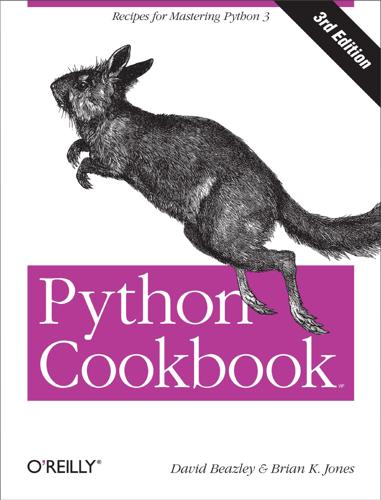
Python Cookbook
by
David Beazley
and
Brian K. Jones
Published 9 May 2013
However, other than that, it’s usually never a bad idea to stick with a more simple approach (simply use methods with different names). Ideas concerning different ways to implement multiple dispatch have floated around the Python community for years. As a decent starting point for that discussion, see Guido van Rossum’s blog post “Five-Minute Multimethods in Python”. 9.21. Avoiding Repetitive Property Methods Problem You are writing classes where you are repeatedly having to define property methods that perform common tasks, such as type checking. You would like to simplify the code so there is not so much code repetition.
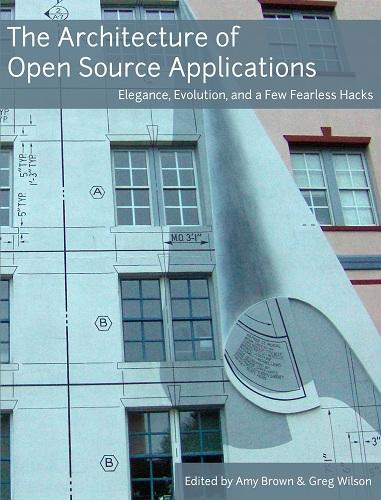
The Architecture of Open Source Applications
by
Amy Brown
and
Greg Wilson
Published 24 May 2011
We were able to write down new PEPs with more confidence in what worked and what did not, and maybe it would have been impossible to do so differently. So it's all about detecting when some third-party tools are contributing innovations that are solving problems and that should ignite a PEP change. 14.6.2. A Package that Enters the Standard Library Has One Foot in the Grave I am paraphrasing Guido van Rossum in the section title, but that's one aspect of the batteries-included philosophy of Python that impacts a lot our efforts. Distutils is part of the standard library and Distutils2 will soon be. A package that's in the standard library is very hard to make evolve. There are of course deprecation processes, where you can kill or change an API after 2 minor versions of Python.
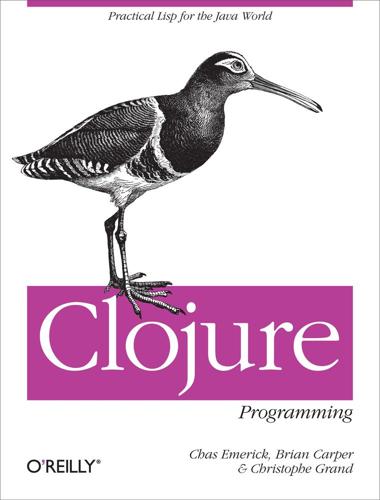
Clojure Programming
by
Chas Emerick
,
Brian Carper
and
Christophe Grand
Published 15 Aug 2011
If your organization starts using Clojure, it will have good company. * * * [437] The Eclipse Public License, which allows for free commercial use and redistribution: http://www.eclipse.org/legal/epl-v10.html. [438] In Clojure’s case, Rich Hickey, who has a role similar to Python’s Guido Van Rossum, Ruby’s Yukihiro Matsumoto, Perl’s Larry Wall, and C++’s Bjarne Stroustrup. [439] All recognized contributors are listed at http://clojure.org/contributing. [440] irc://irc.freenode.net/clojure or in your browser at http://webchat.freenode.net/?channels=#clojure. [441] One of us has run a community-wide survey for the past two years to gauge the origins, mood, and priorities of the Clojure community; full results of the last editing of that survey are available at http://cemerick.com/2011/07/11/results-of-the-2011-state-of-clojure-survey/.
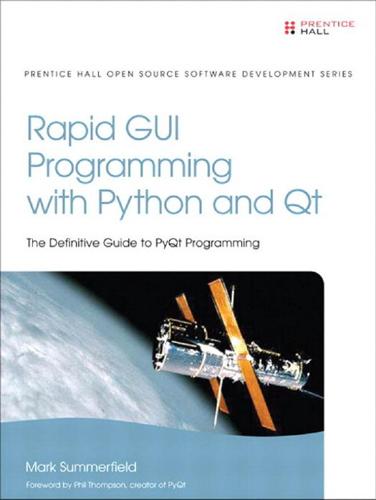
Rapid GUI Programming With Python and Qt
by
Mark Summerfield
Published 27 Oct 2007
He has been supportive of the book from the start, even adding features and improvements to PyQt as a direct result of discussions we have had regarding the book. He has made numerous suggestions for the book’s improvement, and corrected many mistakes and misunderstandings. Special thanks to Samuel Rolland, who let me loose on his Mac laptop, to install PyQt, test the examples, and take screenshots. Thanks are also due to Guido van Rossum, creator of Python, as well as to the wider Python community who have contributed so much to make Python, and especially its libraries, so useful and enjoyable to use. Thanks also to Trolltech, for developing and maintaining Qt, and in particular to the Trolltech developers both past and present, many of whom I have had the pleasure of working with, and who ensure that Qt is the best cross-platform GUI development framework in existence.

Coders at Work
by
Peter Seibel
Published 22 Jun 2009
Then the launch process is the most formal of them all. Then, there is a checklist—it's very formal in terms of security issues. If we launch this, is someone going to be able to go in and do cross-site scripting to take over something else? That's fairly strict. Seibel: You told me once that when Guido van Rossum came here he had to get checked out on Python and Ken Thompson had to get checked out on C, to make sure they could meet very explicit coding standards. Do you have design standards that are equally explicit? Norvig: No. Some of the coding standards go into some design issues, but you get a lot more leeway there.

Real World Haskell
by
Bryan O'Sullivan
,
John Goerzen
,
Donald Stewart
and
Donald Bruce Stewart
Published 2 Dec 2008
Indeed, functional programming as a field was quite obscure. During this time, the mainstream programming world experimented with relatively small tweaks, from programming in C, to C++, to Java. Meanwhile, on the fringes, programmers were beginning to tinker with new, more dynamic languages. Guido van Rossum designed Python; Larry Wall created Perl; and Yukihiro Matsumoto developed Ruby. As these newer languages began to seep into wider use, they spread some crucial ideas. The first was that programmers are not merely capable of working in expressive languages; in fact, they flourish. The second was in part a byproduct of the rapid growth in raw computing power of that era: it’s often smart to sacrifice some execution performance in exchange for a big increase in programmer productivity.
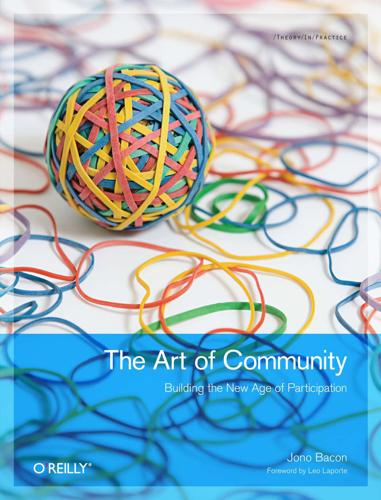
The Art of Community: Building the New Age of Participation
by
Jono Bacon
Published 1 Aug 2009
Surely that can’t actually work! You would be surprised. There are many dictator-led communities that are popular and attract large numbers of people. Two very prominent technical examples of this are Linux and Python. Within these communities exist two highly visible leaders: Linus Torvalds and Guido van Rossum, respectively. Linus and Guido are the people who have traditionally decided on direction, set focus, and accepted or rejected contributions. In the Free Software world, one of the most notable cases of dictatorship was the choice of the third version of the GNU General Public License, perhaps the software license in most widespread use by Free Software projects (including Linux).

Ajax: The Definitive Guide
by
Anthony T. Holdener
Published 25 Jan 2008
LAMP provides a stable, scalable, and cheap web platform for use with any Ajax web application. As the Web 2.0 movement grows with more Ajax web applications replacing the more classic sites, LAMP will be right there as well. Check out O’Reilly’s LAMP site, ONLamp.com, at http://www.onlamp.com/ for more on LAMP. Python Guido van Rossum created Python in 1990, not as a scripting language but as a general-purpose programming language. Python 2.1 came out in 2002 and is significant not just because it combined Python 1.6.1 and Python 2.0 into a single release, but because Python 2.1 was the first version of Python to fall under a new license owned by the Python Software Foundation.